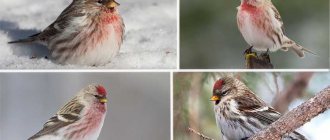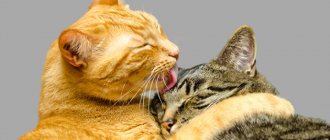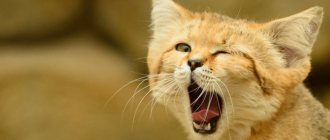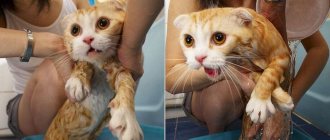The fishing cat or civet cat has recently attracted great interest among exotic lovers. There are also frequent attempts to keep it at home.
It should be remembered that this is not a breed of domestic cat, it is a natural variety of a wild predator. In order for coexistence to be comfortable for everyone, it is necessary to know everything about this rare species.
History of the discovery of the variety
Fishing cats have been known to the indigenous populations of many Asian countries since ancient times. These animals preferred to hide in the thickets of the tropical jungle during the day, so for a long time there were only legends about the ghost cat.
During the development of new territories, extensive deforestation and drainage of wetlands began. Viverrid cats had to adapt to new living conditions; they became more noticeable to people and, unfortunately, became objects of hunting.
Local healers consider almost all parts of the animal’s body valuable, from which they brew numerous potions.
Hunters continue to catch civet kittens for sale, despite the fact that in most countries in the animal's natural range, these actions are punishable by law.
The name of the species was given by the English zoologist and writer Edward Turner Bennett in 1833, having described in detail the morphology and color of the cat, which in India was called “fishing cat”.
In 1958, the name Prionailurus was proposed to the new species by the Russian researcher and naturalist Nikolai Severtsev as a common name for the spotted cat species of Asia, and the name Felis viverrinus rhizophoreus was given by the Dutch scientist Henri Jacob Victor Sodi in 1936. He described in detail the Viverrid cat caught on the coast of West Java. This individual has a slightly shorter skull than specimens previously found in Thailand.
Today, the unique animal has many names - Viverrid, Speckled, Fish, Fisherman, Asian fish cat, Fish cat.
The name Speckled is associated with the fur pattern - the cat's entire body is covered with dark specks.
Viverrid means similar to the tropical predatory mammal civet or civet, mainly due to its secretive lifestyle. The cat is called a fisherman due to its preferences in hunting, fishing and nutrition.
The names of the predator in local dialects are also interesting. In Assamese it is Meseka (fish), in Bengali it is Maha-bagrol or Bagh-Dasha. Maha means fish and Bagha means tiger. In Hindi, the name of the Fishing Cat sounds like Ban-Biral, in Telugu - Bavuru-pilly (wild cat), in Sinhala - Handun Divya, in Thai - Sea-Pla (fish tiger). In Myanmar, this predator is called Kuanga-ta-nga. "Kuanga" means "cat" and "ta-nga" means "fisherman".
Is it possible to keep a civet cat at home?
People destroy the habitats of such animals in every possible way: they cut down forests, drain water bodies, which contributes to their extinction. Breeding these cats at home is strictly prohibited in all countries. Due to the fact that these animals have a very complex character, people may have problems. More than one generation of civet cats gets into squabbles with their own brothers and other inhabitants of the wild, let alone ordinary people.
In general, there are no guarantees that a fishing cat, which came into the family as a tiny kitten, will not conflict with its owner when it becomes an adult, and besides, we must not forget that by nature it is a predator, and this quality is impossible completely eliminate it, it’s in their blood. You will need to establish special contact with the cat, so it is best to contact a specialist regarding issues of upbringing and maintenance. In addition, in addition to describing the breed itself, they can give maximum useful information about what to feed them, how to tame them, and the like. Of course, you can find similar information on the Internet, but, unfortunately, little has been written about them. Basically, they are told about them in a superficial (introductory) form. When writing this article, all information was taken into account.
Description and natural habitat of the Fishing Cat
Prionailurus viverrinus is a species of wild cat that lives throughout the south-eastern lands of Asia.
The fishing cat is a relative of the Far Eastern cat; it has a similar structure and parameters, but is much larger in size.
It is an indigenous inhabitant of the Asian tropics and subtropics, located in India, Indochina, in the forest and coastal regions of Ceylon, Sumatra, and the Java Peninsula. Countries that are also inhabited by this species are Vietnam, Thailand, Pakistan, Sri Lanka, and Cambodia.
The biotopic type of residence of the civet cat is forest zones adjacent to any bodies of water - swamps, lakes, leisurely rivers, tidal areas with thickets of mangroves with roots deep under water. It is here, in the interweaving of mangrove branches, that most of the life of the Speckled Cat comes; here it hunts, builds dens, and hides from humans and other enemies.
It is almost impossible to see the Fishing Cat in the mangrove jungle; it is an invisible predator, so careful that a person can walk a few meters from the animal without noticing it.
Some populations are also found in the high mountain regions of the Himalayas, near mountain streams located at an altitude of about two thousand meters above sea level.
Important! Do not confuse the fishing cat with the house cat. The latter is also called the marsh or jungle cat; read about him and his home maintenance in a separate article.
Viverrid fishing cat in the wild
The civet fishing cat lives in tropical and subtropical regions of Southeast Asia, in Southeast India, Indochina, Sumatra, Ceylon, Java and Bali. Not to be confused with the jungle cat, which differs from the civet both in appearance and in its lifestyle. Fish cats settle near reservoirs, lakes, swamps and slow rivers, in general, wherever they can find food and not be seen by humans. An adult civet cat occupies a territory of 4-8 km2, the territory of males can reach 22 km2.
Fishing cats breed all year round. Pregnancy lasts 63-70 days. Litters are not numerous, usually 2-3 kittens are born. At 4.5 months, the young animals switch to adult food, and by 9 months they catch up with the size of their parents and switch to self-sufficiency. Reaches sexual maturity much later, at 2-3 years. In captivity, males help the female raise offspring; how they behave in the wild is not known for certain. And the rest of the way of life of civets has not been studied well enough.
Video about civet fishing cats:
Mr. Cat recommends: characteristics of the species and subspecies
Viverrid cats belong to the medium-sized cat subspecies. Males are distinguished by their powerful and large bodies, weighing up to 15-17 kg; females are usually at least half as large.
The length of an adult male reaches 120 cm with a height at the withers of about 40 cm. This is a very strong animal with a powerful and strong bone structure.
The head is not too large and long, but wide at the cheekbones. The nose is wide and smooth, with virtually no bridge. The lobe is voluminous, pink, with large nostrils.
The ears are small, set low and located almost on the sides of the head.
The predator has very powerful jaws, for which it is often called the pit bull of the cat world.
The forehead is rounded. The neck is short and powerful. Small eyes are round in shape, the color of the cornea is golden or green-yellow, the dark pupil is elongated vertically.
The limbs are squat and strong. A short tail with dark rings at the end, very wide at the base.
The coat is thick, medium length, grayish or olive-brown in color with a black speckled pattern.
In terms of body shape, thickness of hair, and color, it is very reminiscent of tropical civets; it may well be that in the ancient eras of the planet these were blood relatives, whose descendants followed their own branches of development.
Like most wild cats, the Fishing Cat has a characteristic mask on its face, consisting of bright dark and white stripes on the cheekbones, ear flaps, forehead, and around the eye shells. On the back of the ears there are false “eyes” - snow spots on a charcoal background. In the darkness of the tropical jungle, the cubs are guided by them, following their mother.
Much of the body structure is focused on excellent swimmer qualities - small ears are almost always pressed to the head, a wide nose without a bridge of the nose facilitates underwater breathing, short powerful paws have webbed formations between the toes. They prevent the cat from fully retracting its claws, but they perfectly keep it afloat and help in hunting for fish.
The civet cat dives well and can even hold its breath for a long time.
Densely packed, stiff wool has excellent lubrication and unique water-repellent properties.
The civet cat has two subspecies:
- Prionailurus viverrinus viverrinus lives mainly in India, Southeast Asia and Sumatra, and is large in size.
- Prionailurus viverrinus risophores is common in the Java Peninsula and Bali and is a smaller carnivore.
Description
The civet fishing cat is considered one of the largest species of the subfamily of small cats (Felinae).
He has a strong build and short legs. Its head is elongated and its tail is short, making up approximately one third of its body length. The fur is hard, brownish-gray in color with characteristic dark spots and stripes. The spots are located longitudinally throughout the body. Six to eight dark lines begin above the eyes and extend between the ears to the back of the head. These lines gradually break up into shorter stripes and spots on the shoulders. The fur on the belly is elongated, with characteristic spots, and the tail is ringed. The front feet are partially webbed and do not allow the claws to be fully retracted. The ears are short and round, the back of which is black with a white spot in the center. Sexual dimorphism is highly pronounced, males are much larger than females.
Length: body 658-857 mm; tail 254-280 mm, hind leg 134-158 mm, ears 47-51 mm. Height at withers: more than 350 mm. Weight: 6.3-11.8 kg depending on gender.
One notable feature is the layered structure of their fur, which is important for adaptation to water. Next to the skin is a layer of short hair that is so dense that water cannot penetrate through it. As a close-fitting thermal underwear, this undercoat helps keep the animal's body warm and dry, even during cold fishing expeditions. The second layer of long hair, growing along with the undercoat, gives the cat a characteristic pattern and glossy shine.
Character, temperament
The civet cat is mainly nocturnal and always lives near water. It can climb trees, but very rarely does this; it mainly wanders in shallow water in search of prey.
Very smart and cunning, luring the victim, it hits the water with its paw. When there are ripples on the surface of a reservoir, underwater inhabitants think that this is the movement of insects and rise to the top. An adult is capable of swimming long distances, up to several kilometers.
Sexually mature females and males lead a solitary lifestyle, carefully marking their habitat with their own scent, secretions and claw marks on trees and protecting their territory. So, a female is able to control from 6 to 8 square meters. km., and the male from 16 to 22.
When in danger, adult animals make a characteristic sound reminiscent of laughter.
These are very brave animals, capable of even coping with a leopard or a pack of dogs alone, but they always avoid meeting people.
The speckled cat is available for socialization. The behavior of a civet cat when living next to a person is described below.
Diet
The gastronomic preferences of fishermen are very different from those of most other cats. The basis of their diet is live fish and other aquatic inhabitants: frogs, snails.
Cats hunt in several ways. In search of food, cats can wander for a long time in shallow water or wait on the shore, then with a well-aimed jump they rush at the prey; if necessary, they swim and dive for fish. It is interesting that during hunting they often resort to cunning: they stand motionless in the water and lightly touch the surface with their whiskers. This way they imitate the movement of insects and attract fish. Cats also eat birds, small mammals, rodents and carrion. On land they sometimes hunt insects. In exceptional cases, they may attack larger animals.
What to feed a fisherman at home
A cat's diet at home should be as close to natural as possible. This refers not only to the type and quantity of food, but also to the method of obtaining it. That is, the fisherman should have the opportunity to hunt fish in a body of water, catch a live mouse or gut a bird. Naturally, there will be a lot of dirt as a result of such nutrition. A civet fishing cat can accept any animals that are smaller than it for food. The daily norm is 0.2-0.5 kg of fish or meat.
Considering that the activity and energy needs of domestic cats are much lower than in nature, a hungry or semi-starved day is arranged once or twice a week. The diet is supplemented with chicken or quail eggs and fresh grass.
Health and nutrition
In its natural habitat, the lion's share of the Speckled Cat's food is fish, which makes up more than three-quarters of the diet.
At dusk, the predator goes hunting; to do this, it simply sits on the shore of a reservoir, waiting for prey, occasionally hitting the surface of the water with its paw. If necessary, he is able to dive and sink to the bottom for fish. The rest of the Fishing Cat's diet consists of birds, insects, small rodents, mollusks, reptiles, amphibians, carrion, and occasionally livestock no larger than a lamb.
An adult can eat 1.5-2 kg of fish per day.
Viverrid cats are distinguished by excellent health. When living at home, no problems usually arise. But, like all domestic cats, they are subject to mandatory deworming and vaccination.
In captivity, the life expectancy of the Speckled Cat is 20-25 years, in natural conditions it is less - 10-15.
Features of character and lifestyle
The fisherman cat can be quite aggressive towards other members of the species. In this way he protects his territory and hunting grounds. It is worth noting that these are quite secretive representatives of the cat family that lead a solitary lifestyle.
During mating, animals gather in pairs - this can happen at any time of the year, since they do not have a specific season for prolongation of the genus. But still, more often this happens either in the last winter months, or vice versa - at the beginning of summer.
The fishing kitten, like babies of other species, is quite playful and inquisitive. But their freedom, in the early stages, is limited by the mother, who carefully looks after them, preventing external threats to the life of her offspring.
Fact! In captivity, an interesting feature of this animal species was discovered - males help females in caring for babies. They are caring fathers who also teach their kittens to hunt.
It is very unusual that the cat prefers marshy areas and willingly dives into water. It is these behavioral features that determine the fact that the animal is quite active and successful in hunting not only fish, but also aquatic bird species. To do this, the water cat lowers itself completely into the water. It dives and surfaces directly under the bird, grabbing it with sharp teeth and claws.
Cat fisherman while swimming
In addition, the diet includes various types of mammals. Despite their compact size compared to large cats, they are capable of hunting young sheep, deer, calves, and tiger cubs. Capable of dragging a small dog out of the yard.
Puberty and reproduction
Since this animal leads an extremely secretive lifestyle, it has been studied very little and the reproductive characteristics of the Viverrid cat in natural conditions are practically unknown.
In zoos and nature reserves, the Speckled Cat is able to reproduce year-round; it does not have a clearly defined period of sexual heat; males and females are slightly more active in February-March.
The duration of pregnancy for females ranges from 62 to 72 days. During this period, the male does not leave his friend, lives nearby, takes care of her food, and helps set up her den. The pregnancy of a Viverra cat ends with the birth of two or three small babies (170-200 grams).
In the first three months of life, kittens feed primarily on mother's milk. After thirty days they are already quite active, from two months they begin to play in the water and taste solid food, although they continue to suckle their mother until six months.
The parents take care of the kittens together until they are fully grown and trained in hunting skills. By eight and a half months, adolescents reach the size of an adult animal, but powerful “pit bull” fangs grow only by 11 months, and puberty occurs after 15-18 months.
Feeding of civets
The cat eats mainly fish. It also hunts toads, frogs, crustaceans, snakes, small mammals and birds. They can attack poultry, dogs, goats, and calves. It catches fish during daylight hours; at dusk and at night it can hunt for other prey. While fishing, a fishing cat sits on the bank of a stream or river and waits for fish to swim past, and when it does, it sharply hits the prey with its clawed paw.
The civet cat fisher can climb trees, but he does it reluctantly and does not like it. Loves to walk in shallow water and is a good swimmer. When swimming, it uses its short tail as a rudder. The fishing cat, like many cats, leads a solitary lifestyle. Each animal has its own individual territory.
Captivity
The fishing cat does his best to avoid communicating with humans in the wild, because this is perhaps his main enemy, which has been exterminating the population for centuries.
The civet cat never attacks people first, and a baby born in captivity and taken from its mother early can, with some reservations, become a pet.
It should be mentioned that in many countries of the world the keeping and breeding of these animals is prohibited.
Quite a lot of Fishing Cats are kept in European zoos in special large enclosures with artificial ponds and in nature reserves around the world.
If the owner of the Fishing Cat strictly follows the breeder’s requirements and follows all his recommendations, then there is a chance that the kitten will grow into a fairly adequate animal. At the same time, we must not forget that this is a wild predator and its behavior can never be completely predictable.
Breeders recommend choosing females as pets, since males, upon reaching sexual maturity, even despite early castration, can remain aggressive and actively mark their territory using physiological secretions and marks from claws and teeth.
When raising a kitten, a special approach is required. The Viverra cat has a rather complex and capricious temperament, but at the same time it is a very smart and intellectually developed creature.
It is advisable to pick up a kitten from a breeder at two months of age, then its adaptation to a new place will be faster and easier. In order for the young Fisherman to quickly get used to a new place, he needs to be surrounded with warmth and care, and fed by hand more often.
You need to be very careful when training to use the litter box. You cannot raise your voice at your pet, beat or punish. Only suggestions in a stern voice, encouragement and treats are allowed.
The speckled cat is suspicious of other pets, but prefers not to engage in open confrontations.
You need to play with the baby a lot and for a long time, but in no case with an open hand; you can only use special swings, balls, and other toys. You should not blow into the animal’s nose, as is often done with domestic cats. The speckled cat will simply wave it off with its paws and can cause serious injury to a person.
The Fishing Cat is very fond of playing in the water and the pet needs to be provided with the opportunity for such fun.
If there is no way to arrange a special pond for the cat, then in the apartment you can fill the bathtub with water once a day, it is advisable to put live fish in there and allow the baby to hunt.
They should be fed fresh fish and lean meat, live mice can be given, and the use of vitamin complexes is acceptable. The daily amount of food for an adult animal is about 1.5 kg.
It must be remembered that if you keep a kitten in an enclosure from a young age, it will never grow up to be a tame pet.
A male kitten should be especially carefully monitored during puberty, and it is better to carry out complete sterilization before 8 months. Everyone knows the story of Davis the Fishing Cat, who was an excellent pet until he was one and a half years old, but after he grew up, he began to show signs of aggression and the owners had to part with their beloved savage.
A civet cat, properly raised, will, as it grows up, feel the members of its family in all members of the household, remaining the same kid at heart. Therefore, even a mature pet requires a lot of attention.
Punishment should never be carried out using physical force or raising your voice. A severe reprimand is enough; you can lock the cat alone for a while; a smart animal will quickly understand its guilt.
Keeping an Asian Fish Cat at Home
It should be remembered that breeding of civet cats is prohibited throughout the world. And by the way, if a person decides to get a civet cat, he should remember the need to solve a bunch of related problems.
Firstly, we must not forget that at its core this is a wild animal. Even if you took a small newborn kitten and raised it with love and affection, you should still remain vigilant towards the animal. Be prepared for the fact that small kittens will require quite a lot of time. They are incredibly playful and particularly tender. Kittens of civet cats - fishermen - are much more active than pets.
The Asian fish cat requires special education, and if you have never experienced raising wild animals, you are unlikely to be able to raise an adequate individual.
In order for a cat to begin to respect and love you from infancy, you should feed him literally by hand. To avoid unpleasant situations, the kitten must clearly know that it should only play with toys. Under no circumstances should you shout at civet kittens, much less hit them, this can cause obvious aggression in them. The kittens will want to take revenge on you.
By the age of three, the kitten reaches puberty. From this period of life, big troubles and problems with the kitten await you. The civet cat begins to mark its territory. In addition, he begins to win her back. Become more aggressive. A cat can fall passionately in love with one of the family members, but on the contrary see an enemy in the other. It is quite difficult to resist a cat that has enormous strength and incredibly sharp claws.
If, nevertheless, you decide to get yourself a fishing cat, then you should castrate it (if it’s a cat) or sterilize it (if it’s a cat) before eight months of life.
The best way to keep a civet cat - a fisherman - is a spacious enclosure with grass thickets and a small pond with fish. The enclosure must be surrounded not only on all sides, but also on top with a net. In the enclosure it is necessary to provide, if not trees, then at least shelves of different heights and warm houses for the cat.
Remember that civet cats - fishermen - do not tolerate cold weather well. For this reason, it is necessary to maintain a positive temperature in their houses in the enclosure.
Purchasing a civet kitten
In order to purchase this exotic animal, a special permit from the Federal Service for Supervision of Natural Resources is required, since the Fishing Cat is listed in the International Red Book (CITES 2) and is protected.
You can buy a kitten only in special nurseries in which all breeding animals were born in the country of purchase, have permits and are legal. However, due to the adoption of new restrictive laws in Russia on the keeping of wild animals, this is becoming increasingly difficult to do.
The cost of an animal in our country starts from 300 thousand rubles, in the world - from 10 thousand dollars.
Mysterious beast from the mangrove forest
Asian fish cat, fishing cat, wiverina, speckled cat - all these are different names for one very interesting and unusual animal, secretly living in the humid mangroves of the Asian tropics and subtropics. The civet fishing cat belongs to a small, even endangered species of the cat family and in every possible way avoids close contact with humans.
The fishing cat is a unique representative of the cat world
Therefore, it is still almost unstudied - at least in its natural habitat, and we can only guess about its natural habits and characteristics from the behavior of those individuals kept in captivity. But how accurate such assumptions are remains a big question. The mysterious animal belongs to a small, isolated genus of oriental cats and in some respects differs significantly from its brethren in its extensive family.
Scientists distinguish two subspecies of fishing cats, differing primarily in their size. Smaller, more elegant and graceful individuals settle in Bali and Java. Representatives of the large subspecies are much more widespread - these animals live in the South and Southeast of Asia, in India, up to Sumatra and Malacca.
This cat prefers to walk by himself
Relationships with a person
Drainage and human development of wetlands where the fish cat prefers to settle is gradually displacing the animal from its original habitats. Illegal hunting for the civet cat continues - local residents shoot it for its beautiful skin, and often exterminate it in retaliation for the theft of small domestic animals.
In Eastern medicine, various parts of the body, bones and skin of a speckled cat have been considered medicinal since time immemorial and are still used to prepare medicine potions - and this is another article in the barbaric extermination of rare animals.
Local residents, despite prohibitions, catch wild cats in the wild
Despite the fact that the endangered species was listed in the International Red Book back in 2008, the natives do not stand on ceremony with this animal. It is caught in the wild and smuggled to other countries, where in recent years there has been a growing fashion for keeping exotic wild cats in private zoos. There is information about nurseries involved in breeding and selling fishing cats, but only a few of them operate within the framework of the law.
Interesting facts about the Fisherman cat
- The fishing cat has a unique jaw structure and very powerful fangs, allowing it to hunt large prey. This is a true "feline pit bull terrier".
- False “eyes” on the back of the ears are also an indicator of the animal’s condition. If they are not visible, it means that the ears are pressed to the head, and the cat is angry and dangerous.
- The size of female Anglers corresponds to the size of an ordinary domestic cat with a more powerful build, but males are at least twice as large.
- When diving, a civet cat is able to press its ears very tightly to its head, protecting them from water.
- The Speckled Cat's nose also has a special structure that allows it to hold its breath and prevent water from entering the respiratory tract.
Population and species status
Photo: Animal fishing cat
A rare fishing cat can become a legend if a person does not think about his harmful activities, which affect many animals. The population of this feline species has declined so much that the threat of its extinction is more pressing than ever. Fishing cats are dying out due to unfavorable environmental conditions, thanks to the destruction of swamps and deforestation. Often, animals do not have enough food due to mass hunting and fishing. Hunting activities to exterminate fishing cats because of their fur and fangs also brought negative and depressing results.
Description of the breed
In appearance, the speckled cat, as it is also called, is something between a Far Eastern cat and a civet. It is relatively small, but quite large relative to its domesticated furry relatives. The average weight of males is 15 kg, females - 10. Inside the small body lies uncontrollable strength and power: according to rumors, in a fight with a leopard, the fish cat always remains the winner.
The head of the animal is of interest: it is round with a massive lower jaw. The shape of the ears and nose is ideal for diving. The front toes are webbed, which is why the cat never retracts its claws.
The hunter’s exclusively terrestrial lifestyle also affected his gait: his body was squat with powerful, short legs. Unlike other representatives of the cat fauna, the civet's tail is short and thick, and does not taper towards the bottom. He uses it instead of a rudder when swimming.
The camouflage gray-brown-black coat color allows the cat to remain unnoticed in the thickets of the tropical jungle.











